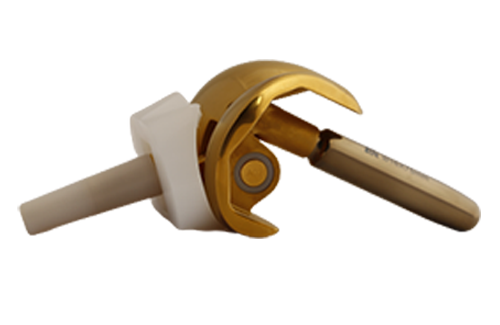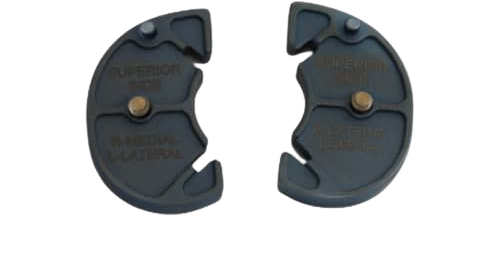Buechel-Pappas™
Hinge Knee System
- Primary load bearing of the B-P Hinge Knee is carried by the tibiofemoral articulating surfaces and not by the hinge element as it is in other hinge knee designs.
- This allows for the use of a relatively small hinge which needs only to resist shear forces and not the much greater compression forces.
- The tibiofemoral articulating surfaces of this knee are fully congruent in all phases of flexion resulting in very low contact stress for all activities.
We Balance Gaps!
Design Rationale

- Pappas recognized a need for a condylar bearing hinge knee prosthesis utilizing the bearing arrangement.
- In this combination the bearing arrangement is used to transfer most of the loading from the femur to the tibial through the condylar surfaces of the femoral and tibial components.
- The hinge, in contrast to the prior art devices, is used only for knee stabilization rather than load transfer.
- This allows the use of relatively small hinge elements producing a lighter weight device which requires significantly less removal of bone than typical hinge load bearing knee replacements.
- Minimizing bone removal is desirable since implant fixation is often improved where more bone is retained.
BP Hinge Knee Assembly

- A femoral component with a femoral stabilizing implanted rod has condylar surfaces of different radii which mate with a UHMWPE bearing.
- A mating tibial platform is stabilized in the tibia with a rod, the bearing translating on the platform in the posterior-anterior directions in response to knee flexion and extension.
- The bearing bears the full extension load on congruent articulating contact regions with the condylar surfaces and lesser flexion loads via incongruent articulating contact.
- A hinge assembly is pinned to the femoral condylar component through a head having a depending shaft fixed to a UHMWPE tapered bearing axially floating and rotatably movable in a tibia platform component mating cavity.
- The head passes through the bearing and stops the bearing translations at extreme posterior and anterior positions.
Features and Benefits
- Hinge Knee Implant has Hinge Knee Femoral component assembly with the carriage shaft locked into the femoral component, Hinge Knee Tibial platform, Stem, screw and wedges.
- Hinge Knee Implants are available in sizes 2, 3 & 4.
- Rotating Hinge allows axial rotation reducing the stresses at the Bone-Cement-Implant interface.
- The use of a small hinge reduces the necessary bone resection to less than that associated with most Posterior Stabilized designs.
- A stem may also be used to traverse shaft fractures.
- Availability of metallic augments to compensate for bone loss.
- A series of such augments is provided for both femoral and tibial augmentation.
- To minimize the risk of metal to metal rubbing these augments are intended only for use only with cement which acts to separate the metallic elements
Wedges

- Distal, Posterior and Tibial wedges options are available
- Metallic augments to compensate for bone loss.
- A series of such augments is provided for both femoral and tibial augmentation.
- Distal Femoral augments are available in six sizes two thicknesses (5 and 10mm).
- Posterior Femoral augments are available in six sizes, three thicknesses (5, 10, and 15mm).
- Tibial augments are available in six sizes, three thicknesses (5, 10 and 15mm).
Instrumentation
- The additional instrumentation required to implant the Hinge components is minimal, consisting only of a box osteotome for each femoral size to prepare the cavity for the hinge pin.
- Minimal additional instrumentation is associated with the implantation of the B-P revision components.
- This simplicity of instrumentation reduces cost and complexity of revision and salvage surgery, a situation where such reduction is badly needed.
Extra Resources
| Buechel Pappas Revision & Hinge Surgical Protocol |
